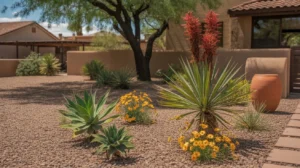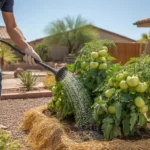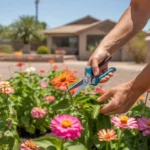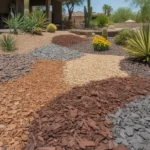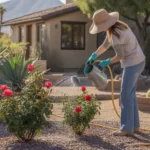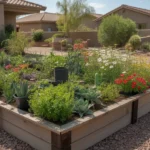As the scorching summer sun beats down on Southeast Valley yards, it’s easy to think gardening season is over. But with some smart strategies and desert-wise plant picks, you can keep your landscape looking lush even in triple-digit temperatures. Here’s how to help your garden beat the heat and transition beautifully from spring to summer.
Embrace the Dry Bloom
While spring bursts with lush growth and color, summer in the desert takes on a different kind of beauty. Many native plants have adapted to thrive in hot, dry conditions by developing smaller leaves, waxy coatings, or shedding foliage altogether. Others sprout towering flower stalks that add striking architectural interest.
Lean into this “dry bloom” aesthetic by incorporating heat-loving stars like desert marigold, blackfoot daisy, and red yucca. Their sunny flowers and sculptural forms celebrate the season rather than fighting it. Succulents like agave, paddle plant, and desert spoon also shine now, their fleshy leaves plump with stored moisture.
By choosing plants that naturally thrive in summer, you can spend less time coddling and more time enjoying the distinct beauty of the season. Visit local nurseries to discover varieties well-suited to Southeast Valley conditions.
Water Deeply, But Wisely
With temperatures regularly soaring above 100°F, summer watering can feel like a constant battle. But some simple shifts in your irrigation routine can keep plants hydrated without wasting water. The key is to water deeply and infrequently, giving plants a long drink that penetrates deep into the soil.
For most established plants, one or two deep waterings per week is plenty. Avoid frequent shallow sprinklings, which evaporate quickly and encourage weak surface roots. Instead, give each plant a long, slow soak until you see water starting to run off. Then let the top few inches of soil dry out before watering again.
Watering early in the day, between 4-8 am, helps plants absorb moisture before the intense midday heat. If you have an automatic irrigation system, adjust it seasonally to account for longer, hotter days. Adding a timer can also help you fine-tune watering without having to trek out in the heat.
Mulch Like Mad
If there’s one desert gardening “super tip”, it’s to mulch heavily. A 3-4 inch layer of organic material like bark chips, straw, or shredded leaves does wonders for retaining moisture and keeping roots cool. As a bonus, as mulch breaks down, it adds nutrient-rich organic matter to the soil.
Gravel and rock also make excellent heat-busting mulches. Their light-colored surfaces reflect the sun’s rays rather than absorbing them like dark soil or pavement. Try surrounding heat-sensitive plants with a “cool collar” of light pebbles to create a microclimate that’s a few degrees lower.
Whichever mulch you choose, be sure to leave a few inches of space around the base of trees and shrubs. Piling material against the trunk can trap moisture and lead to rot. Refresh mulch every spring after danger of frost has passed to keep your summer garden looking tidy and well-tended.
Provide Shade Where It Counts
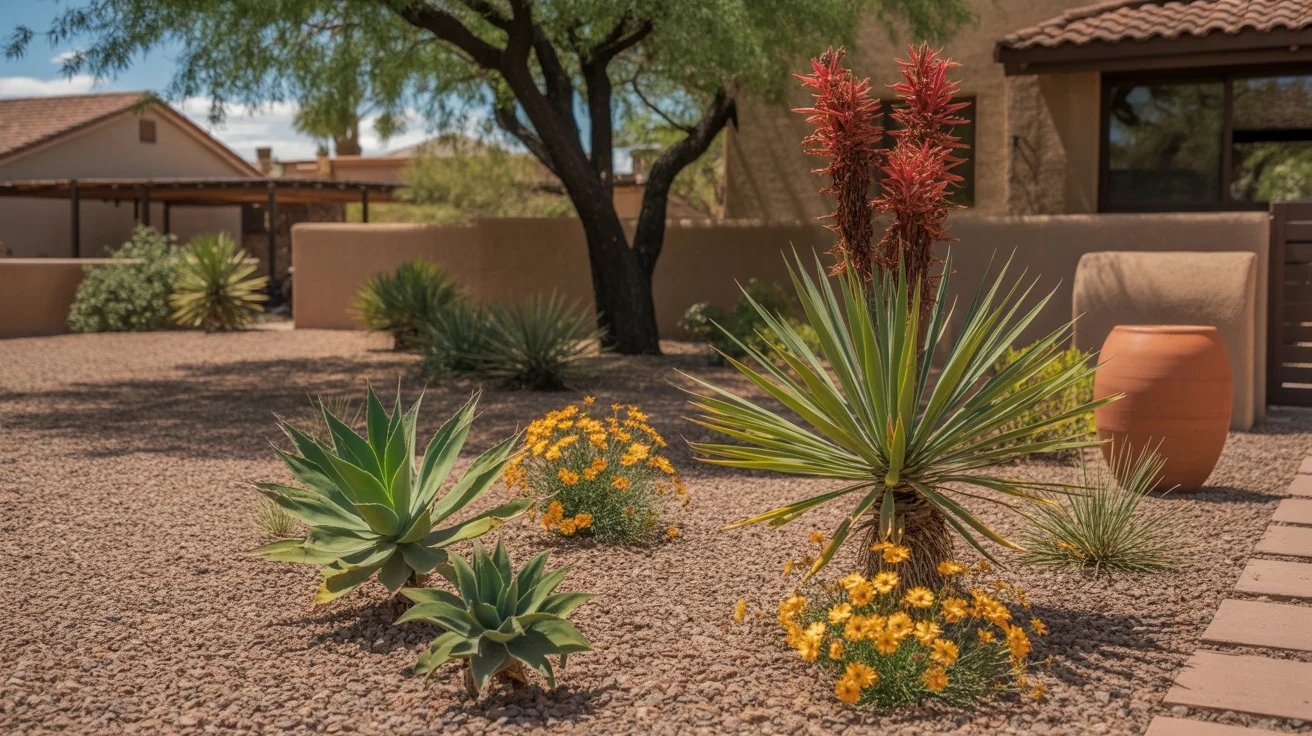
In the brutal heat of summer, even sun-loving plants can benefit from a bit of shade. Tender new transplants, shallow-rooted annuals, and container gardens are especially vulnerable to sun scorch. Give them a reprieve by providing temporary shade structures.
Shade cloth, available at garden centers, is an easy way to diffuse light without completely blocking it. Drape it over hoops or a simple frame to create a dappled oasis for sensitive plants. Umbrellas, lattice panels, or even strategically placed patio furniture can also cast welcome shade.
For a longer-term solution, consider planting summer screens. Fast-growing vines like queen’s wreath or native Arizona canyon grape can quickly turn a trellis or arbor into a shady retreat. Tall, airy plants like desert willow or palo verde create a natural canopy that lets light filter through while shielding plants beneath.
Tackle Pests Proactively
Hot weather doesn’t just stress plants – it can also bring a surge in pest populations. Aphids, whiteflies, and spider mites thrive in the dry heat, quickly multiplying to damaging numbers. Catch them early by inspecting plants regularly, especially on the undersides of leaves where pests like to hide.
When you spot an infestation, act fast. A sharp blast from the hose can dislodge aphids and mites, while sticky traps can capture whiteflies. Insecticidal soaps, made from natural fatty acids, can tackle soft-bodied insects if applied frequently. As a last resort, targeted applications of neem oil or pyrethrin can knock back heavy infestations.
Encouraging beneficial insects is another great way to keep pests in check. Ladybugs, lacewings, and parasitic wasps all prey voraciously on common garden pests. Lure them to your yard by planting small-flowered herbs like dill, fennel, and yarrow among your summer blooms. Avoiding broad-spectrum pesticides will also help these “good guys” stick around.
Fertilize Sparingly
It’s tempting to give heat-stressed plants an extra dose of fertilizer, but resist the urge. Excessive nutrients, especially nitrogen, can actually make plants more vulnerable to heat and drought by encouraging lush, water-hungry growth. Overfed plants may also attract more sap-sucking pests.
Instead, focus on slow-release, organic fertilizers that nourish the soil as well as the plant. Compost, well-aged manure, and natural blends like fish emulsion provide a steady, balanced diet without overdoing it. Apply them in spring and early summer, then ease off as the heat intensifies.
If plants still seem to be struggling, consider a foliar feed instead of a root drench. Spraying diluted kelp or seaweed extract directly on leaves can give plants a quick boost of micronutrients without overloading the soil. Do this in the cool of morning, before the sun has a chance to scorch damp foliage.
Embrace a Little Wilt
Despite your best efforts, you may still see plants wilting in the afternoon heat. Don’t panic – this is a normal defense mechanism that helps plants conserve moisture. As long as leaves perk back up in the evening or early morning, there’s no need for emergency watering.
In fact, letting plants wilt a bit between waterings can actually help them develop deeper, more drought-resistant roots. The temporary stress signals the plant to send roots farther down in search of moisture. As a result, the plant is better equipped to handle future dry spells.
Of course, if a plant remains wilted for more than a day or starts dropping leaves, it may need a deep drink. Check soil moisture by sticking your finger in up to the second knuckle. If it feels dry at that depth, give the plant a long, slow soak until water runs out the bottom of the pot or soil.
With a little know-how and desert-smart strategies, you can keep your Southeast Valley garden thriving all summer long. By working with the rhythms of the season rather than against them, you’ll create a landscape that’s as resilient as it is beautiful – no matter how high the mercury rises.

